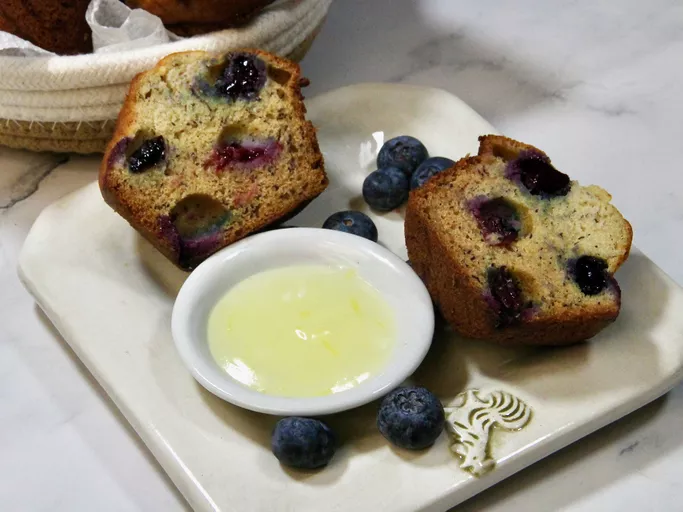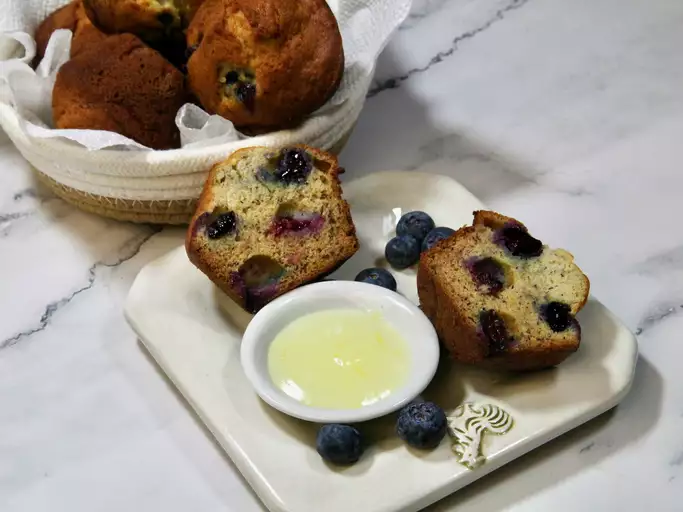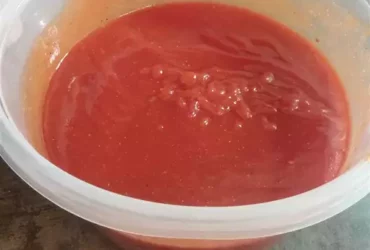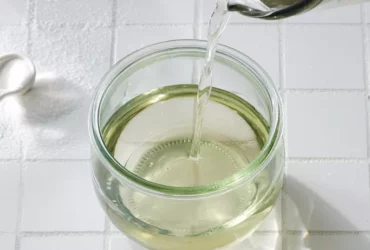Ingredients
List of essential items
To make a classic Lemon Butter recipe, you’ll need the following ingredients:
- Butter: 1 cup (2 sticks) unsalted butter, softened
- Lemons: 2-3 lemons, depending on their size and your desired level of lemoniness
- Salt: a pinch of salt to bring out the flavors
- Granulated sugar: 1-2 tablespoons, optional (but recommended for balance)
- Finely chopped fresh parsley or chives: 1 tablespoon, optional (for garnish and added freshness)
For the best flavor and texture, use high-quality, European-style unsalted butter with a high fat content.
Note: If you don’t have access to fresh lemons, you can substitute with bottled lemon juice. However, keep in mind that the flavor might not be as vibrant and authentic.
Make sure to soften the butter to room temperature before starting to ensure it’s pliable and easy to mix with other ingredients.
Using a microplane or fine grater, grate the zest of 1-2 lemons, depending on your desired level of lemon flavor. Be careful not to grate too much, as this can be bitter.
Squeeze the juice of 1-2 lemons into a small bowl, again depending on your desired level of lemoniness. Strain the seeds and pulp from the juice using a fine-mesh sieve or cheesecloth.
The Lemon Butter Recipe requires some essential ingredients to achieve its distinct flavor and texture. These include unsalted butter, which provides a rich and creamy base for the sauce, as well as freshly squeezed lemon juice, which adds a burst of citrus flavor.
Additional key ingredients are granulated sugar, which balances out the acidity from the lemon juice, salt, to enhance the flavors and texture, and finally, fresh parsley, chopped finely, to add freshness and visual appeal to the dish.
These core ingredients can be combined with other components such as garlic powder or minced garlic for added depth of flavor, and heavy cream or milk if a lighter consistency is desired, making the Lemon Butter Recipe versatile and adaptable to individual tastes.
The quality and freshness of these ingredients directly impact the final taste and presentation of the dish, emphasizing the importance of selecting high-quality materials whenever possible.
Understanding how each component contributes to the overall flavor profile allows individuals to make informed decisions about ingredient substitutions or omissions, ensuring that the Lemon Butter Recipe remains authentic while accommodating various dietary needs or preferences.
With its focus on incorporating natural ingredients and minimal processing, this recipe aligns with contemporary culinary trends that prioritize health-conscious eating and environmentally friendly practices.
The harmony between tangy lemon, sweet sugar, creamy butter, and earthy parsley underscores the potential of simple yet complementary flavors to elevate even the most basic dishes into masterpieces of culinary art.
1 cup (200g) unsalted butter, softened
To make the delicious lemon butter recipe, we will start with a fundamental ingredient that adds flavor and richness to our final product – 1 cup (200g) unsalted butter, softened.
The key characteristic of this ingredient is its softness, which allows it to be easily whipped into a light and airy consistency. This can be achieved by leaving the butter at room temperature for about 30 minutes before using it or by gently warming it in a double boiler over low heat.
It’s worth noting that the use of unsalted butter is crucial in this recipe as it allows us to control the amount of salt added to our lemon butter. Salted butter, on the other hand, contains a significant amount of sodium chloride, which can alter the flavor profile and balance of the final product.
As we work with 200g of softened butter, it’s essential to choose high-quality, European-style or cultured unsalted butter for the best results. These types of butter tend to have a higher fat content (around 82-86%) than regular salted butter, which means they will yield a richer and more flavorful lemon butter.
The next step in making our lemon butter recipe is to add a few well-chosen ingredients that will complement the flavor and aroma of our softened unsalted butter. We’ll be discussing these ingredients in further detail as we progress through the recipe, but for now, let’s focus on the importance of using high-quality, freshly softened unsalted butter as the base for our delicious lemon butter.
2 tablespoons freshly squeezed lemon juice
The inclusion of 2 tablespoons of freshly squeezed lemon juice in the Lemon Butter Recipe serves a multifaceted purpose, contributing to both the flavor and preservation properties of the final product.
Flavor Contribution
- Lemon juice adds a distinct citrus taste, which complements the richness of butter perfectly. This contrast enhances the overall flavor profile of the Lemon Butter.
- The acidity in lemon juice cuts through the fattiness of butter, creating a sense that is both tangy and creamy at the same time.
Preservation Properties
- The acidity in lemon juice acts as a natural preservative. The acid pH level helps to prevent the growth of bacteria, thereby extending the shelf life of the Lemon Butter.
Chemical Reaction with Butterfat
- The acidity in lemon juice reacts with the butterfat molecules. This reaction is crucial for the emulsification process, allowing the ingredients to mix and blend smoothly.
- The result of this chemical interaction is a stable and smooth consistency, which is vital for achieving the desired texture in the Lemon Butter Recipe.
Therefore, the inclusion of freshly squeezed lemon juice in the Lemon Butter Recipe plays a dual role by contributing to both its flavor profile and preservation properties.
2 cloves garlic, minced
- The first ingredient in this lemon butter recipe is garlic, specifically 2 cloves that are minced.
- In terms of quantity, 2 cloves of garlic equate to a relatively small amount of this flavorful ingredient.
- This amount may vary depending on the desired level of garlic flavor in the final dish, but for most applications, 2 cloves are sufficient.
- The cloves should be peeled and minced before adding them to the recipe, as this will release their potent flavor and aroma.
- To mince the garlic, simply chop or crush it with a knife or other tool until it reaches the desired consistency.
- When working with garlic in general, it’s essential to note that the pungent smell is a result of an enzyme called alliinase.
- This enzyme breaks down the sulfur compounds in garlic and produces allicin, which gives it its characteristic flavor and aroma.
- The allicin then reacts with oxygen in the air to produce sulfenic acid, which causes the irritating sensation associated with chopping or crushing garlic.
- Minced garlic is an essential component of many recipes, particularly those featuring savory flavors like lemon butter.
- The combination of garlic and lemon creates a harmonious balance that elevates dishes to new heights.
- In this specific recipe, the garlic adds depth without overpowering the subtle citrus flavor of the lemons.
1 teaspoon salt
- Lemon is not an ingredient used in this step, but it’s crucial for the overall recipe.
- The task requires measuring 1 teaspoon of salt.
- Salt is a crystalline mineral composed primarily of sodium chloride.
- It’s commonly used to add flavor and texture to various dishes.
- In the context of this lemon butter recipe, the salt serves to balance out the acidity from the lemon juice.
- The correct measurement is crucial to maintain the desired flavor profile, so ensure you’re using a precise teaspoon measuring spoon.
- If you prefer a milder taste, consider reducing the amount of salt used.
- Conversely, if you want to emphasize the savory aspect of the recipe, you could increase it slightly within reason.
- Keep in mind that overusing salt can alter the overall character of your dish, so exercise caution when adjusting this ingredient.
1/4 teaspoon black pepper
The ingredients used in this lemon butter recipe are carefully selected to enhance the flavor and aroma of the final product. The most notable ingredient is unsalted butter, which serves as the base for the entire dish.
A high-quality unsalted butter is essential to ensure that the lemon butter tastes rich and creamy. You can use a European-style or American-style unsalted butter, depending on your personal preference.
The next key ingredient is freshly squeezed lemon juice, which adds a bright and citrusy flavor to the lemon butter. Be sure to use a manual or electric juicer to extract the juice from a fresh lemon.
Granulated sugar is also an essential component of this recipe, adding sweetness without overpowering the other flavors. You can adjust the amount of sugar to your taste, but a general rule of thumb is to use 1-2 tablespoons per half cup of unsalted butter.
The spice that takes center stage in this lemon butter recipe is black pepper. A small quantity of 1/4 teaspoon is used to add depth and warmth without overpowering the other flavors.
Other ingredients like grated ginger, minced garlic, or chopped fresh herbs can be added to enhance the flavor and aroma of the lemon butter. However, they are not essential, and you can omit them if you prefer a more straightforward recipe.
The freshness and quality of the ingredients used in this recipe will directly impact the taste and aroma of the final product. Be sure to use high-quality unsalted butter, fresh lemons, and other ingredients to ensure that your lemon butter turns out rich, creamy, and full of flavor.
The key to creating a delicious Lemon Butter recipe lies in the selection of high-quality ingredients.
Here are the essential components you’ll need to get started:
Essential Ingredients
- Lemons: Fresh lemons are a must-have for this recipe. You can use either Eureka or Lisbon varieties, but make sure they’re organic and free of any blemishes.
- Butter: High-quality unsalted butter is crucial in this recipe. Choose a European-style or cultured butter for the best flavor.
- Salt: A flaky sea salt like Maldon or Fleur de Sel adds depth and texture to your lemon butter.
Optional Ingredients
- Pantry staples: If you want to add a bit of extra flavor, you can include pantry staples like garlic powder, onion powder, or paprika in your mixture.
- Fresh herbs: Chopped fresh herbs like parsley, dill, or tarragon can enhance the citrus flavor and add freshness to your lemon butter.
- Spices: A pinch of cayenne pepper or red pepper flakes can add a spicy kick to your lemon butter, perfect for those who love a bit of heat.
When selecting your ingredients, remember that the quality of each component will directly impact the final taste and texture of your Lemon Butter recipe. Choose fresh, high-quality ingredients to ensure the best results.
Instructions
Cooking and blending
Cooking and following instructions are crucial components in preparing a variety of dishes, including recipes that require blending ingredients together. The lemon butter recipe, for instance, necessitates careful attention to detail to ensure the final product turns out as intended.
Here’s an overview of the steps involved in creating a lemon butter recipe:
Pull Together Required Ingredients and Tools
To make a lemon butter recipe, one needs to have certain ingredients on hand. These typically include lemons, unsalted butter, granulated sugar, kosher salt, black pepper, and heavy cream.
Zest the Lemons
The zest of two lemons should be peeled off using a zester or fine grater. Be cautious not to get too much of the white pith, as this can make the dish bitter.
Melt Butter in Saucepan
In a medium saucepan, melt one-half cup (one stick) of unsalted butter over low heat.
Add Sugar and Salt to Melted Butter
Once the butter has melted, add one tablespoon of granulated sugar and half a teaspoon of kosher salt. Stir until they are fully dissolved in the melted butter.
Pour in Heavy Cream
Gradually pour in one-half cup of heavy cream into the saucepan containing the melted butter mixture. Be careful not to let it boil over.
Blend Zest and Mixture Together
Add the lemon zest into the saucepan with the butter mixture and blend everything together until well-combined.
Pour Lemon Butter on Pasta or Asparagus
Use the lemon butter as a topping for cooked pasta or steamed asparagus. Simply pour it over your dish of choice, ensuring an even coating throughout.
Season with Black Pepper to Taste
Lastly, add black pepper to taste and serve immediately. You can also refrigerate any leftover lemon butter in the fridge for later use.
This recipe yields a tangy yet rich lemon butter that complements various dishes, including pasta and steamed asparagus. When following the instructions carefully and using fresh ingredients, the outcome is sure to be enjoyable and satisfying.
Lemon butter is a simple yet elegant condiment that can elevate a variety of dishes from seafood to vegetables, and even use as a topping for bread.
To make lemon butter, you will need just four ingredients:
- 1/2 cup (1 stick) unsalted butter
- 2 tablespoons freshly squeezed lemon juice
- 1 tablespoon grated lemon zest
- Salt to taste
Here’s a step-by-step guide on how to make lemon butter:
Step 1: Soften the Butter
Melt the butter in a saucepan over low heat, or until it reaches a softened state.
Step 2: Mix with Lemon Juice and Zest
Add the freshly squeezed lemon juice and grated lemon zest to the softened butter. Stir until well combined.
Step 3: Add Salt to Taste
Add salt to taste, making sure not to over-salt the mixture.
Step 4: Chill the Lemon Butter
Transfer the lemon butter mixture to a bowl or container and refrigerate for at least an hour before using.
Serving Suggestions:
- Use as a topping for grilled fish, chicken, or seafood
- Pour over roasted vegetables such as broccoli or Brussels sprouts
- Spread on toasted bread for a flavorful snack or side dish
Lemon butter can be stored in an airtight container in the refrigerator for up to 2 weeks, making it a great condiment to have on hand. Simply soften the chilled lemon butter at room temperature before using.
Melt the softened butter in a saucepan over low heat.
The process of melting softened butter in a saucepan over low heat is a crucial step in creating a rich and tangy lemon butter sauce for various dishes, particularly seafood or vegetables. This delicate operation requires patience and attention to detail to avoid burning or scorching the butter, which can easily occur due to high heat.
To begin with, ensure that you have softened butter at room temperature before attempting to melt it over low heat. Softened butter is easier to work with as it melts more evenly than cold butter. You may leave it on your kitchen counter for about 30 minutes to allow it to reach the ideal temperature and consistency.
Once you’re ready to proceed, place a saucepan over medium-low heat on your stovetop. For optimal results, choose a heavy-bottomed saucepan as it distributes heat evenly and minimizes hotspots that can cause scorching.
As the pan begins to warm up, carefully add the softened butter to it in small increments. You can use a tablespoon or spoonful at first to test the temperature. The moment you place the butter into the pan, adjust the heat setting immediately to low. This initial addition helps the butter start melting smoothly.
Monitor your saucepan closely during this process as melted butter is highly susceptible to burning when exposed to high temperatures. You’ll notice the butter start turning from a solid mass to a creamy liquid over the next 2-3 minutes, depending on its quantity and quality.
To avoid overheating, never allow the melted butter to come into contact with direct flame or intense heat from other burners nearby. This would instantly cause the butter to darken in color and develop an unpleasantly strong odor due to the Maillard reaction – a chemical reaction that occurs when amino acids and reducing sugars react with each other upon heating.
After melting your softened butter, you can proceed with adding lemon juice or zest as required by the lemon butter recipe you are following. Stir carefully until well combined before using it on dishes like steamed fish or vegetables for added flavor and a hint of citrusy freshness.
Remember that practice makes perfect when working with melted butter over low heat, so feel free to experiment with different amounts and temperatures as needed. Happy cooking!
Add the lemon juice, garlic, salt, and black pepper to the melted butter.
In this critical step of our lemon butter recipe, it’s essential to combine the ingredients in a specific order and manner to achieve the perfect balance of flavors.
The process begins by adding the melted butter to a mixing bowl or saucepan. This will provide a base for the other ingredients to blend into seamlessly. Ensure that the butter is fully incorporated before proceeding with the next step to prevent any clumps or unevenness in texture.
Next, we introduce the lemon juice to the melted butter. This is typically done by squeezing the fresh lemons or opening the pre-squeezed lemon juice bottle, depending on your preference and accessibility. Be cautious not to add too much at once; a squeeze of one half to one full lemon is usually sufficient for most recipes.
Follow the addition of lemon juice by sprinkling in the minced garlic. The amount you use will depend on personal taste; some prefer a light hint, while others enjoy a more pronounced flavor. Be mindful not to add too much as it can quickly overpower other tastes.
In conjunction with the garlic, sprinkle salt and black pepper over the mixture to enhance the overall flavor profile. Salt serves multiple roles: It not only brings out flavors but also balances the acidity from the lemon juice. Pepper adds a subtle yet discernible heat and depth that complements both lemon and garlic nicely.
Stir the mixture constantly for about 23 minutes or until it thickens slightly.
The process of stirring the mixture is a crucial step in preparing the lemon butter recipe. It’s essential to maintain a smooth and even consistency throughout the cooking time.
Here are some key considerations when it comes to stirring the mixture:
- The temperature of the mixture should be monitored closely, as it can quickly go from perfectly cooked to burnt.
- Stirring constantly will help prevent lumps and ensure a smooth consistency in the final product.
- A spatula or whisk is ideal for stirring, as they allow for easy manipulation of the mixture without causing it to stick or form lumps.
As you stir the mixture constantly, observe its texture and consistency. After about 23 minutes of continuous stirring, the mixture should have thickened slightly. This is a good indication that it’s ready to be used as lemon butter in your recipe.
If the mixture doesn’t seem to be thickening at all after 23 minutes, it may be worth checking the heat level or trying to cook it for a little longer, taking care not to overcook it. Conversely, if it starts to thicken too quickly, simply reduce the heat and continue stirring slowly.
Once you’re satisfied that the mixture has reached the desired consistency, you can use it as lemon butter in various recipes or store it in an airtight container for later use.
The art of following instructions is a crucial aspect of any recipe, and when it comes to making lemon butter, clarity and precision are key. In this article, we will break down each step of the process, ensuring that you have all the information you need to create a delicious and tangy spread.
Here’s what you’ll need:
- Lemons: 2-3 fresh lemons, depending on their size and your desired level of lemoniness
- butter: 1/2 cup (110g) salted or unsalted butter, softened to room temperature
- Salt: a pinch, about 1/4 teaspoon
- Cream: 2 tablespoons heavy cream or buttermilk
- Zest: the grated zest of 1 lemon (about 1 tablespoon)
Now that we have our ingredients, let’s move on to the instructions:
Step 1: Zest and Juice the Lemons
- Zest the lemons using a zester or a fine grater, taking care not to grate too much of the white pith underneath.
- Juice the lemons into a small bowl, straining out any seeds or pulp.
Step 2: Soften the Butter
- Leave the softened butter at room temperature for about 30 minutes to soften further.
Step 3: Mix the Lemon Zest and Juice into the Butter
- In a separate mixing bowl, combine the lemon zest, lemon juice, and a pinch of salt. Mix well until the zest is evenly distributed.
- Add the softened butter to the mixing bowl with the lemon mixture, beating with an electric mixer or by hand using a wooden spoon until smooth and creamy.
Step 4: Add Cream and Whisk Until Combined
- Gradually pour in the cream while whisking continuously. Beat until combined and stiff peaks form.
Step 5: Season to Taste and Chill
- Taste the lemon butter and adjust the seasoning as needed by adding more salt, lemon zest, or juice.
- Cover the bowl with plastic wrap and refrigerate for at least 30 minutes before serving or storing in an airtight container.
Now you have your very own lemon butter recipe to enjoy on toast, muffins, scones, or as a topping for baked goods. Make sure to store it properly in the fridge and give it time to mature – this will only enhance its flavor!
Tips and Variations
Adding a twist
Lemon butter, a tangy and aromatic spread, can be enjoyed on its own or used as an accompaniment to various dishes. When making lemon butter, it’s essential to balance the acidity of the lemon with the richness of the butter. To achieve this equilibrium, you may experiment with different proportions of lemon juice and butter.
In addition to adjusting the ratio of lemon to butter, there are numerous ways to add a twist to your lemon butter. One popular variation involves incorporating garlic or herbs into the mixture. For example, you can try adding some minced garlic or fresh rosemary leaves to give your lemon butter a distinct flavor profile.
Another way to enhance your lemon butter is to use different types of citrus fruits. While traditional lemon butter typically employs lemons, you can also try using limes or oranges as alternatives. Limes will produce a slightly sweeter and more robust taste, while oranges will add a hint of sweetness.
You can also experiment with spices to create unique variations. For example, adding some cayenne pepper will give your lemon butter a spicy kick, while incorporating grated ginger will add warmth and depth.
An additional way to mix things up is by using different types of milk or cream in place of traditional butter. For instance, you can try making lemon yogurt butter by mixing lemon juice with yogurt and then blending it with some oil to create a creamy consistency.
Lastly, consider incorporating various textures into your lemon butter. You could add some chopped nuts or seeds for added crunch or try using different types of cheese for an extra burst of flavor.
In conclusion, while traditional lemon butter is always a delight, experimenting with these variations can lead to the discovery of entirely new and exciting flavors. So go ahead and get creative – your taste buds will thank you!
To take your lemon butter recipe to the next level, consider adding some creative twists to the classic mixture.
Citrus Variations: Experiment with different citrus fruits like lime, orange, or grapefruit to create unique flavor profiles. For instance:
- Lime butter adds a bright and zesty taste perfect for pairing with grilled fish or chicken.
- Orange butter brings a warm and inviting flavor ideal for use in baked goods or as a sauce for pork chops.
Spice It Up: Infuse your lemon butter with aromatic spices to create a bold and aromatic spread. Try adding:
- A pinch of red pepper flakes for an extra kick of heat.
- A sprinkle of paprika or cayenne pepper for added depth and warmth.
Herbaceous Twists: Introduce fresh herbs into your lemon butter to add a fragrant and herbaceous flavor. Consider adding:
- Fresh parsley or dill for a bright and refreshing taste perfect for using as a sauce for seafood.
- Chopped rosemary or thyme for a savory and earthy flavor ideal for pairing with roasted meats or vegetables.
Nutty Delights: Add some crunch and nuttiness to your lemon butter by incorporating different types of nuts or seeds. Try:
- Chopped almonds or walnuts for added texture and flavor.
- Pumpkin seeds or sunflower seeds for a nutty and slightly sweet taste.
Smoky Flavors: Add a smoky depth to your lemon butter by incorporating ingredients like:
- Chipotle peppers in adobo sauce for a spicy and smoky flavor.
- Smoked paprika or chipotle powder for added heat and depth.
Feel free to experiment with different combinations of these variations to create unique flavors that suit your taste preferences!
Add some grated lemon zest to give it an extra burst of citrus flavor.
To elevate this classic lemon butter recipe to the next level, consider incorporating some creative variations and additional flavor enhancers.
One simple yet impactful addition is adding some grated lemon zest to the mixture. This will not only amplify the citrus flavors but also introduce a delightful textural element to the dish.
When grating the lemon zest, be sure to use a fine grater or zester to avoid any bitter or woody flavors that can sometimes occur when using a coarse grater.
To balance out the brightness of the lemon, try incorporating some creamy elements into the mixture. For instance, you could add a tablespoon or two of plain Greek yogurt or sour cream to temper the acidity and create a more velvety texture.
For those looking to experiment with different flavor profiles, consider substituting some of the traditional lemon juice with other citrus options like lime, orange, or grapefruit. This can result in unique and intriguing variations that will add a twist to the classic recipe.
If you’re feeling adventurous, try adding some chopped fresh herbs like parsley, dill, or chives to the mixture for an added burst of freshness and depth. Be cautious not to overpower the dish with too many herbs, as their flavors can quickly become overwhelming.
Another idea is to incorporate some aromatic spices or seasonings that complement the citrus flavors. Cinnamon, nutmeg, or cardamom could add a warm, spicy element to balance out the brightness of the lemon.
When it comes to using this lemon butter in various dishes, consider pairing it with lighter flavors like steamed vegetables, grilled fish, or sautéed chicken for an added layer of depth and complexity. It can also be used as a sauce base for pasta or risotto for a rich and satisfying main course.
Try using different types of citrus fruits, such as limes or oranges, for a unique twist on the classic recipe.
The art of elevating a simple dish into an extraordinary one lies in its ability to be adaptable and versatile, which is exactly what happens when you experiment with different types of citrus fruits. For those who wish to stray from the traditional lemon butter recipe, incorporating limes or oranges will yield a distinct yet equally delicious outcome.
Using limes adds a touch of tropical flair to the classic lemon butter recipe. Limes possess a slightly sweeter and more acidic flavor profile compared to lemons, which makes them an excellent choice for those who prefer their citrus with a hint of subtlety. To incorporate limes into your dish, simply substitute 2-3 limes for each lemon in the original recipe.
Orange butter is another delightful variation on the classic recipe that combines the zest and juice of oranges to create an aromatic spread. This version works particularly well with roasted meats or vegetables due to its slightly sweeter and more complex flavor profile compared to traditional lemon butter.
Another approach is to blend different citrus fruits, such as lemons, limes, and oranges, to create a unique fusion that captures the essence of multiple citrus flavors. This can be done by adjusting the ratio of each type of citrus according to your taste preferences. Experimenting with various combinations will yield an array of distinct flavor profiles.
Additionally, incorporating herbs such as parsley or thyme adds an extra layer of depth and complexity to the citrus butter mixture. The fresh aroma of herbs complements the citrus perfectly without overpowering it. Simply chop the desired herb finely and fold it into the softened butter along with your chosen citrus zest.
A last yet not least aspect of this recipe is experimentation. Feel free to combine different citrus fruits, herbs, or spices in various ways until you arrive at a unique flavor that suits your taste buds perfectly. The beauty of this recipe lies in its malleability and ability to be transformed based on personal preferences.
These variations not only showcase the adaptability but also provide endless opportunities for creative expression. Remember, the key to creating an extraordinary dish is understanding that it’s okay to step away from tradition every now and then and try something new and exciting.
When it comes to making a delicious Lemon Butter recipe, there are several tips and variations that can elevate this classic condiment to new heights.
Choosing the Right Ingredients: The quality of your lemon butter will greatly depend on the ingredients you use. Make sure to select fresh, high-quality lemons with a good balance of acidity and sweetness. You’ll also want to use unsalted butter with a high fat content for a rich and creamy texture.
Making Variations: Adding Herbs and Spices: One of the best ways to mix things up is to add various herbs and spices to your lemon butter. Here are some popular options:
- Cilantro: Add some freshness with a handful of cilantro leaves or a sprinkle of ground cilantro.
- Garlic: Mix in some minced garlic for an extra depth of flavor.
- Dill: Add a hint of anise with some chopped fresh dill weed.
- Paprika: Give your lemon butter a smoky twist with a sprinkle of smoked paprika.
Spicing It Up
Adding Zest and Juice: To give your lemon butter an extra boost, try adding some grated lemon zest or a squeeze of fresh lemon juice. You can also mix in some lemon curd for a tangy and sweet flavor combination.
Tips for Serving
Lemon butter is a versatile condiment that can be used on a variety of dishes, from meats to vegetables to breads. Here are some serving suggestions:
- Grilled Meats: Serve lemon butter alongside grilled meats like salmon or chicken.
- Roasted Vegetables: Toss roasted vegetables like asparagus or Brussels sprouts with a pat of lemon butter for added flavor.
- Baked Goods: Use lemon butter to make delicious baked goods like lemon bars or lemon poppy seed muffins.
By following these tips and variations, you can create a range of delicious and unique lemon butter recipes that will elevate any meal or snack.
- Best Lusha Alternatives for 2025 - April 22, 2025
- Best Overloop Alternatives for 2025 - April 22, 2025
- Best 6sense Alternatives for 2025 - April 22, 2025















